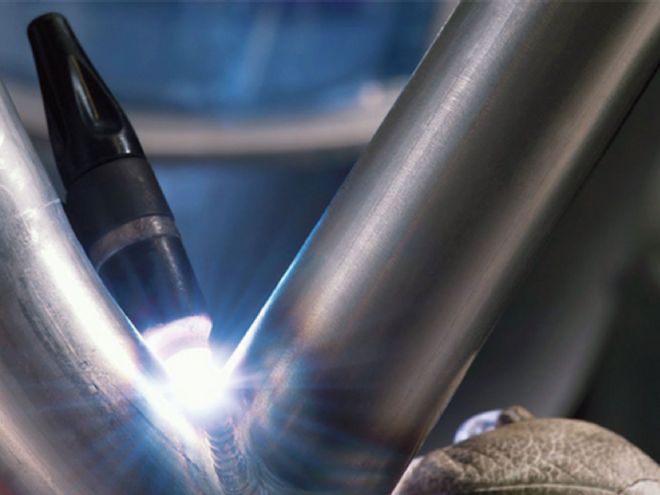
Now that the season is over you may be one of those racers who is either looking at getting into a new chassis for next year or, unfortunately, having to put a clip on your current one because that final race of the year didn’t exactly go the way you were hoping. Regardless of which category you fall into you now have a decision to make. And that decision is what type of tubing to use.
Thanks to Indianapolis-based metals distributor, AED Motorsports, tubing is no longer just tubing and steel is no longer just steel. Since 1995, AED has specialized in supplying the motorsports and performance equipment industries with high-quality metals. These guys maintain an inventory of products and materials specific to the fabrication of race cars, tools and equipment. So when it comes to building chassis AED can point you in the right direction. It supplies many of the Sprint and Drag Car chassis builders as well as NASCAR and IndyCar teams in the country.
AED Motorsports’ new Docol R8 tubing is a better, safer alternative to use when building your race car’s chassis
In the past you had the choice of building a racecar chassis out of either mild steel or 4130 chromoly. But now there is Docol R8. Pronounced (apologies for the Homer Simpson reference) Doh-cul, the material comes out of Sweden from a steel company that AED has an exclusive deal with. The Swedes specialize in high-quality, very clean materials a lot of which is used in the U.S. for the automotive market, not in tubular dimensions but flat steel that gets fabricated into A-pillars, roof bars, bumpers, foot boxes, and so on. This material is used for over the road vehicles that have to conform to government safety standards. AED is the first to have it produced in a round tubular dimension for motorsports applications.
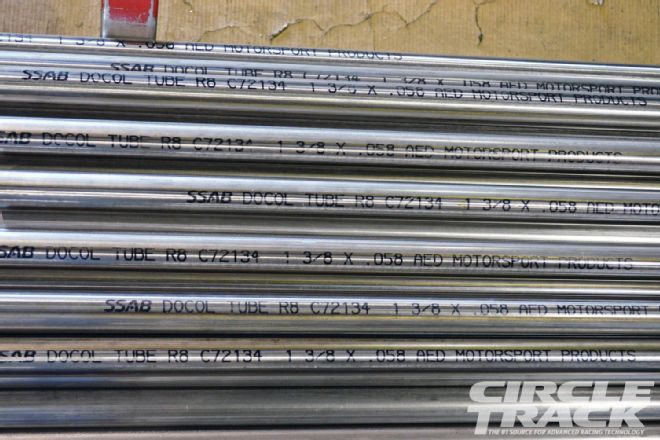 A stack of Docol R8 tubing awaits shipment to chassis builders at AED Motorsports, the exclusive distributor of this type of roll bar tubing. This 0.058 wall thickness is destined for drag cars but by the time you read this AED will have plenty of 0.095 for oval track applications.
A stack of Docol R8 tubing awaits shipment to chassis builders at AED Motorsports, the exclusive distributor of this type of roll bar tubing. This 0.058 wall thickness is destined for drag cars but by the time you read this AED will have plenty of 0.095 for oval track applications.
AED’s Al Lowe has been working on developing another material suitably comparable to 4130 for about 5 years. “I was introduced to SSAB about two and a half years ago through a couple of drag car guys that are part of SFI chassis committee, Murf McKinney and Mats Erikson to give them credit,” says Lowe.
While getting the product market ready has been a slow process thanks in part to the differing cultures and the fact that AED is a small family owned business and their Swedish counterparts are a huge steel company, the benefits of Docol R8 is well worth the wait and the effort.
So What Is It?
“First and foremost Docol is a very clean material. It comes in a surface finish that doesn’t require any cleaning or scotch brighting like you would with the aircraft materials,” explains Lowe. “For example, before fabrication, 4130 should be prepared first with a thorough cleaning, and then using a Scotch-Bright pad to get a good finish surface where as Docol is more like a mild steel, a clean finish.”
Beyond its hygienic properties comes the good stuff. “It is a very consistent product both mechanically and dimensionally because of the manufacturing process used to make the tube,” says Lowe. “It’s rolled into a tube and then welded, therefore you can control the thickness of the wall. The consistency of the wall thickness is much better in a flat strip than you would find in other typical manufacturing processes, like 4130 or the DOM material more typically found in stock car applications.”
To carry that a step further, Lowe says that the consistency of the dimensions and the mechanical properties should generate a repeatable and consistent chassis. Think of it this way, you’ve heard some of the higher level racers say this car does not work the same way as that car but the same guy built the chassis on the same fixture. This is a direct result of the varying consistency of the metals. “Docol’s manufacturing process should produce near identical or the best opportunity for identical cars we have ever had,” says Lowe.
Easy to Work With?
Docol R8 is also conducive to heavy fabrication. Because it’s clean and not a heavy alloyed product like a 4130, titaniums, or other steels the weld zone (heat affected zone) is much smaller and more comparable to the parent material. “Docol R8 is not as brittle in the weld zone as 4130 or some of our other steels,” says Lowe. “It’s also very formable so we won’t have much change with our bending and fabrication processes and it can also be easily welded to 4130 or mild steel. Plus we can use the same filler materials for the cars as you would the 4130.”
In other words, when you bend or weld any metal you change its properties, which include its strength, at the point at which you touched it. In Docol’s case, that change at those touch points is minimal compared to the aforementioned other metals. That in turn makes Docol R8 a better stronger option for fabrication.
On the surface it sounds like Docol R8 is not only a better product to make race car chassis out of but it is an easier product for someone to use as well. Lowe agrees, “I liken it to if you are a good welder, it will make you look great. If you are a great welder, it will make you look like a rock star. And those aren’t my words, those are descriptions that came back from other fabricators. We’ve had Ganassi Racing, Lincoln Electric and Brian Butler at Butlerbuilt Seats all evaluate the material. We have had several labs evaluate them as well. We have put it out there in good capable hands, gotten some good favorable feedback on the quality of the material and the consistency of the material.”
Quality, consistency and ease of use translate into something that could very well potentially impact the whole of short track racing.
The Safer Material?
The 2013 season has been a tough year for short track racing, bringing safety concerns to the forefront of bench racing discussions. Beyond your standard safety equipment can the design of the car and what it is constructed of make a difference in how safe you are? Here at Circle Track we know it can and Al confirmed our beliefs.
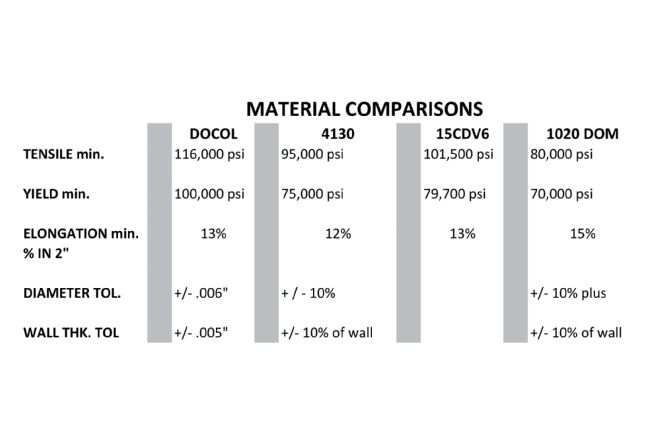 They say that the numbers don’t lie. This chart shows how Docol R8’s tensile and yield strengths are far superior than those of the metals we normally use to build our chassis.
They say that the numbers don’t lie. This chart shows how Docol R8’s tensile and yield strengths are far superior than those of the metals we normally use to build our chassis.
“Yes, I can absolutely say that it is going to be a safer material,” he said emphatically. “It’s 15-20 percent stronger than 4130. It is more tolerant to the high heat and welded zones. It is not as brittle, so it should deform under impact more consistently than 4130 or any other material for that matter.”
Pretty strong position so we asked Al to explain what he meant by “deforming more consistently under an impact” as we were curious as to how that is going to make the racers safer.
“Now that’s one they have to open up their mind a little bit and think about the past. A little story that goes along with that is how come we can see two cars hit the wall relatively the same way and the same speed, one driver walks away, one driver drives away in an ambulance and the two cars are in two completely different conditions. The inconsistencies in the materials that we are accustomed to using do not allow us to control how that material will fail. Because Docol is so consistent on its manufacturing process, particularly dimensionally, that is the material will collapse or crush the same way each and every time.”
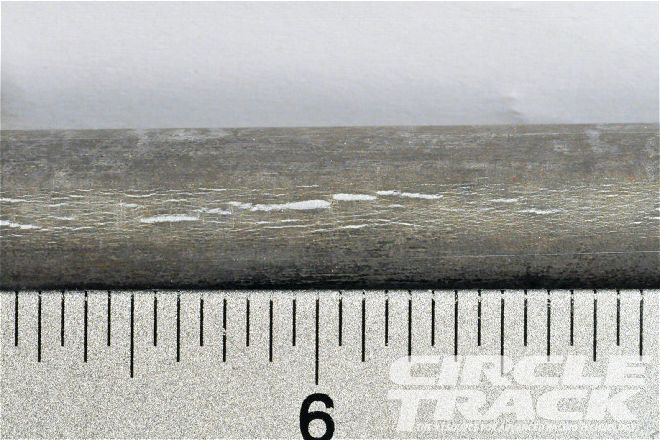 This close-up view of the fine cracks found in the 4130 tubing after the flattening test.
This close-up view of the fine cracks found in the 4130 tubing after the flattening test.
“With that in mind that is why this product is so successful in our automotive industry. Bumpers, foot boxes, door bars, crash bars in production cars. They want something that’s very repeatable. That’s what this material was created for, very repeatable characteristics. The stock car, the big stock car NASCAR guys they are so heavy and overly triangular. When we look at our Sprint Cars and the vast majority of our Modified and Late Models they aren’t as heavily triangulated as a NASCAR stock car. In an accident they do deform much, much more. Docol will give them more control, consistency and understanding the deformation of the material.”
All of that translates into predictability. If car designers and chassis builders were able to predict exactly how a vehicle would react in a particular crash they could design that car to protect the driver better than they ever have in the past.
That predictability and repeatability also holds an exciting potential. Having that consistency across platforms (meaning the individual chassis from a single builder), you could conceivably end up with better racing. Because giving the platform for the racer to build off of is more even. So you really are putting the burden of creating the fast car on the engineering side of how you put the whole thing together. What components you are using for your suspension system, engine choices and so forth.
So Now You Want It
Better, safer racing all from a change in roll bar material? It’s not that far out of reason. In the past racing drove technology improvements in passenger cars. In this particular case, over the road vehicle safety technology has driven an improvement in how we race. It’s an example of Detroit technology going in the opposite direction.
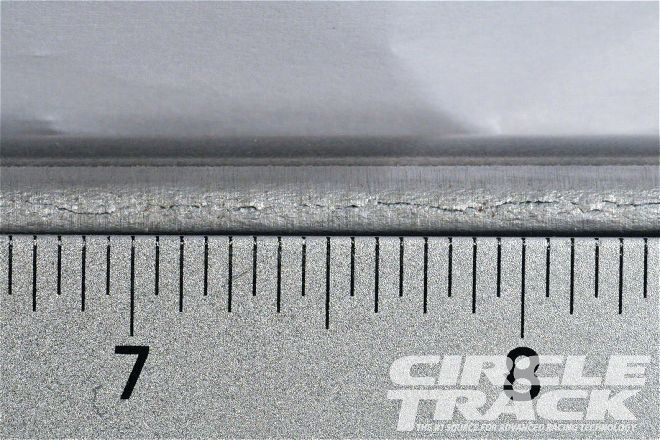 This is the Docol R8 tubing after the same test. As you can see the cracks are substantially smaller. One important point to note is all metal at some point will crack, fracture or deform under the right circumstances.
This is the Docol R8 tubing after the same test. As you can see the cracks are substantially smaller. One important point to note is all metal at some point will crack, fracture or deform under the right circumstances.
At the time of this interview AED already had the SFI spec material for the full body drag cars as well as Top Fuel and Nitro Funny Cars (SFI Spec. 2.3N and 10) while the .095 wall material needed for Sprints, Stockers and Midgets was in production. By the time you read this, those materials should be on AED’s shelves. In fact, several Midget builders have already signed on to build their next cars with Docol R8.
As you might guess thanks to all of its superior attributes, Docol R8 is more expensive than a typical 4130 or mild steel but remember it’s a better material and when things are better they are not necessarily going to be cheaper. You should expect to pay about 12-14 percent more for the Docal R8 over 4130. Now that’s a small price to pay for a better, stronger material for the foundation of your next race car.